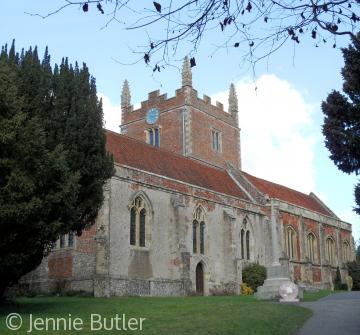Old Basing (Basing) Probate Material 1521 to 1700

About half of the parish of Old Basing lies on chalk, with the sands and gravels of the Reading beds running through the centre of the village from NW to SE, separating the chalk uplands (up to 100m OD) in the south from the low-lying London clays (c.60m OD). The river Loddon flows from the chalk just west of Basingstoke through the village towards Reading, the River Lyde, another eventual tributary of the Thames, touches the parish on the south and east. Petty’s Brook, another tributary, forms part of the boundary. The variety of soils has had an impact on the agricultural richness of the parish.
The parish is not heavily wooded, most of the woodland being on the clay soils, or plantations within Hackwood Park in the south. The river Loddon has determined the form of the village which grew up mainly on the south bank above the flood plain between the two best crossing points.
Basing parish had four manors: Basing, Byfleet, Hackwood and Lychpit. One of the earliest references to the place-name is the Battle of Basing in the Anglo-Saxon Chronicle in 871 when Alfred (before he became king) was defeated by the Danes. In Domesday, it formed part of the holding of Hugh de Port, the family who retained lordship living in Basing for a long time. It passed to the Paulet family and William Paulet in the 16th century rose to great heights in the government and rebuilt Basing House so that it became the grandest private residence in the land, visited by all the Tudor monarchs. In the 17th century it was famous for the stalwart defence of the house for King Charles during the civil wars by the fifth Marquis John Paulet. It was finally taken by Oliver Cromwell in October 1645 and was completely destroyed by Act of Parliament. It is said that houses in the village were built using bricks from Basing House. In the 18th century, the main Hampshire seat of the family, by then Dukes of Bolton, moved across the park to Hackwood House, which is not in Basing parish. The estate remained an entity until the mid 20th century.
Wills and inventories survive for Old Basing in Hampshire Record Office (HRO) and The National Archives (TNA). These are being transcribed by the Wills Group of the New Victoria County of Hampshire project based in Basingstoke and will be published in the near future. These transcriptions have been made from copies of original probate documents supplied by HRO and TNA. Words have been modernized and punctuation added to make reading easier but names have been transcribed as written. Words in italics indicate omissions in the original document which have been added to make sense of the text. Words in square brackets indicate that they have been transcribed as seen but where the meaning is unclear. Old Basing is described as Basing being in the county of Southampton, the old name for Hampshire.
A glossary is attached of unusual words and links to the documents are below.
- Old Basing Probate Material 1521-40
- Old Basing Probate Material 1541-60
- Old Basing Probate Material 1561-80
- Old Basing Probate Material 1581-1600
- Old Basing Probate Material 1601-20
Content derived from research undertaken as part of the Victoria County History project

